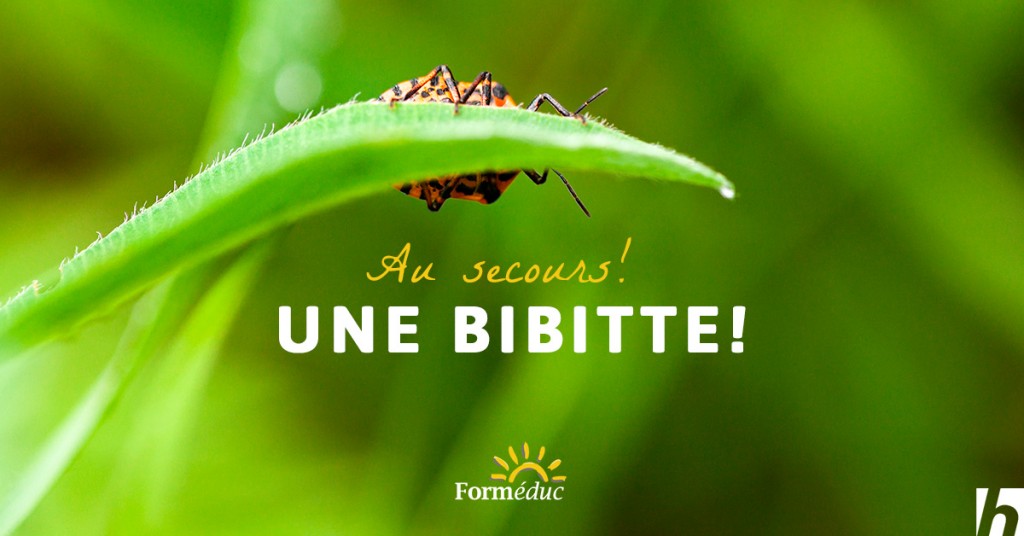

- 8 June 2020
- |
- Andrée Bouchard
The fine weather has finally arrived. The sun and its warmth, the birds, the pleasures of swimming, the vacations. And we’re not the only ones enjoying the good weather… the insects are in too. They’re everywhere! Inside and out, night and day. They fly, they crawl, they sting, they make holes – in short, they’re very busy.
While some children are fascinated by bugs, others are terrorized by their very presence. So we chase them away, but they come back… And sometimes we even kill them, at the child’s request, thinking that this will solve the problem once and for all.
However, killing insects is not the solution for the child who is afraid, because his problem is not the insect, it’s his fear itself, and this problem is called entomophobia (fear of insects).
The entomophobic child is therefore afraid of flies, bees, wasps, ants, spiders, worms, caterpillars, earwigs, woodlice… in short, just about anything that has 6 or more legs, a three-part body (head-thorax-abdomen), crawls, wears wings or has antennae. That’s a lot of little critters to worry about, even if the vast majority of insects living in Quebec are completely harmless.
What is a phobia ?
A phobia is a fear reaction that causes anxiety. Some children suffer from chronic anxiety. Phobic children have anxieties that are centered or focused on an object. This article talks about the fear of insects, but phobias can involve countless other objects, such as darkness, wind, crowds, garbage trucks, dogs, fire… the list is endless.
But let’s get back to our sheep… or rather our bugs!
Entomophobic children will do anything to avoid being confronted with the object of their fear. They refuse to touch insects, go out of their way to avoid approaching them, startle, scream or cry at the sight of them, and often ask us to chase them away or kill them. These reactions are part of the avoidance process, a kind of protective reflex that momentarily reassures the child.
Insect phobia can be traumatic in origin (e.g., a child who is afraid of an insect because it has previously bitten him), or contextual (e.g., a child who is afraid of an insect because he has been threatened that it will attack him).
How does fear of insects differ from other fears? ?
What’s special about insects is that they’re often small, can fly, and can appear from anywhere at any time. In short, an insect is unpredictable. We never know what direction it will take or what it will do, and this notion of uncertainty increases the child’s discomfort with insects.
How to help a child who is afraid of insects ?
The entomophobic child is unhappy and anxious. His fear can make him capricious or unpleasant, and can even provoke nightmares or night terrors. It’s important to help them, if you don’t want this phobia to follow them into adulthood.
Here are a few ways to help children tame their fear:
- Find out why he’s afraid. Has he ever been bitten? Has someone terrorized him or her? Has he witnessed someone else’s fear? Instead of telling him not to be afraid, ask him why.
- Don’t overdo it! Phobias, like any other child behavior, can be fueled by all the attention adults pay to them. Emphasizing his strengths will prevent him from using his fears to attract negative attention.
- Don’t panic yourself. Children imitate your behavior. If you scream at the sight of a bee, your child will associate the insect with danger. Try to adopt a good attitude by remaining calm. Use humor (small bees don’t eat big bees!).
- Inform the child. Fear often stems from a lack of information. The child may believe that all insects sting or hurt. Take your child to observe insects in nature, or get him books on insects to show him that insects are useful and can be interesting to look at.
- Never force a child to touch or pick up an insect against his will. You’ll only aggravate the child’s fear. Avoid telling him not to be afraid, or laughing at his fear. For him, the anxiety felt in the presence of an insect is very real.
- Praise him when he shows courage. Remind him of the times when he overcame his fear.
- Suggest activities involving insects. To feel in control, children need to take action. Through games, drawings or stories, children can express and confront their fears. For example, capturing an insect in a jar will enable the child to observe it, without having to touch it.
Remember: The goal is to help the child tame his fear, not the insect. He’ll probably never like bugs, but his quality of life will improve if he learns to cope with his discomfort and manage his anxiety.
Have a great summer!




